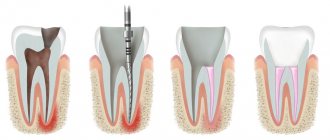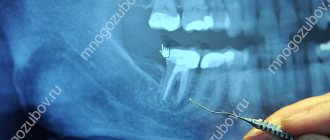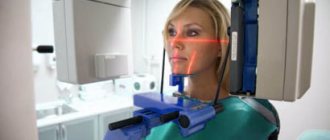If you ask a dentist what he hates doing most in his job, 8 out of 10 doctors will answer: “Cleaning root canals.” Dislike for the preparatory stage before obturation (filling) is associated with the complex structure of the root canals. At the same time, preliminary X-ray diagnostics do not always show the anatomical features of the root canal of a particular tooth. And dentists are well aware of the sad consequences of poor-quality obturation of root canals, ranging from a small focus of infection to extensive periodontal inflammation and tooth loss.
When working with root canals, dentists use a classification compiled in 1984, which includes eight different root canal configurations. But, despite all the knowledge in this area, each case of endodontic treatment is “an improvisation on a well-learned topic,” where each tooth requires an individual approach to treatment.
In clinical practice, the apical zone is recommended as a physiological level for instrumentation and root canal filling. According to a number of authors, in 75% of cases the apical foramen is deviated from the main axis of the tooth. This means that the apex visible on the X-ray image and the apical constriction are often located at different levels.
Methods for determining the working length of the canal
There are several methods for determining the working length of the root canal:
- Mathematical (tabular) method. Special tables (for example, according to JI Ingle, LK Bakland) provide the lengths of teeth and roots, as well as the ratio of crown and root sizes, the number and frequency of canals in the root, apical openings in the canal, and the direction of bending of the canal. This method is quite popular, but requires taking into account corrections of ± 10-15% for the individual characteristics of the patient.
- The tactile method is based on measuring the length of the instrument inserted until resistance appears in the root canal. The method is subjective and therefore unreliable.
- The red dot (paper point) method involves inserting a paper point into the dried root canal until the tip of the point becomes moist with tissue fluid. The appearance of moisture at the top of the pin indicates that the paper pin has reached the apical foramen, and the length of such a paper pin is taken as the working length of the root canal.
- The X-ray method is the most common and its results are considered the most reliable. However, this method does not provide an idea of the location of the apical constriction and the apical opening of the canal, which often does not coincide with the radiographic root apex and may be at a distance of several millimeters from it.
What else do you need to know?
The principle of operation of an apex locator is quite simple. It involves the use of two electrodes, one of them is fixed on the patient’s lip, the second in a file. The device is inserted into the canal and slowly moves along it. Reliable data is displayed on the monitor. In this case, the dentist can obtain a graphic model of the tooth root. The device allows you to determine the zone of the apical structure, the large hole, and the exit of the instrument beyond the apex. With its help, the exact length of the working channel is calculated in the range of 0.5 m.
The image is displayed with magnification, which is very important for diagnosis. This allows you to accurately determine the location of the file relative to the top of the holes. The movement of the device is accompanied by a sound signal, which increases as it approaches the apex. All this allows you to determine with maximum accuracy the depth of the channel that needs cleaning. Do not forget that the first measurement is the most reliable. When diagnosing complex systems, data may be unreliable, so several measurement cycles are required.
Other parameters may also affect the accuracy of the results. Clinical experience with the use of an apex locator has shown that a decrease in the reliability of measurements is associated with the use of files that have been in use for a long period of time. Do not forget that significant sterilization cycles of the device can also negatively affect its accuracy.
An apex locator is an indispensable device in modern dentistry. Its use does not cause any discomfort in patients. Diagnostics does not take much time; in just a few minutes you can get a reliable picture of what is happening in the root canal. This device is widely used in dental treatment and prosthetics. It has a fairly simple design, rarely fails, and is produced by many well-known companies that specialize in the manufacture of medical equipment. The apex locator is widely used by specialists at our dental clinic.
Electronic measurement method or How an apex locator works
The electronic method of measuring the working length of the canal using an apex locator does not have the disadvantages of the above methods. Apex location is based on measuring the electrical resistance between the hard tissues of the tooth and the periodontal tissues and oral mucosa. During the procedure, a mouthpiece (passive electrode) is attached to the patient’s lip on the side of the diseased tooth and an endodontic file (active electrode) is inserted into the canal. When the file reaches the periodontal tissue, the electrical circuit is closed and the device beeps.
Important points
The apex locator appeared on the market relatively recently, but has already won the respect of experienced dentists. It allows for accurate diagnosis and provision of a filling for the patient, even if he suffers from last-degree caries. Using this device, you can determine the presence of perforations and cracks in the problem area. It can be used in any environment (if there is blood in the mouth, etc.).
When diagnosing with an apex locator, there are some important points to consider:
- The device is often used in conjunction with x-rays for more accurate diagnosis. This is because if there is a perforation in the tooth or a root fracture, the device may show unreliable data. In addition, the apex locator is not used if there are even minor remains of filling material or sawdust in the canals.
- There is usually a lot of saliva in the oral cavity. It can create significant interference in the operation of the device, which negatively affects the final readings. Therefore, when using the device, it is necessary to isolate the tooth as much as possible and pump out saliva from the oral cavity.
- The apex locator is an electrical device, so that it shows accurate data, the root canal should not be too wet or dry. Therefore, before measuring, it is necessary to stop the bleeding and dry the root canal as much as possible.
Do not forget that the reliability of the result can be affected by metal crowns located in close proximity to the problem tooth. In addition, a mobile phone or tablet can influence the results of the study. Before the procedure, these gadgets must be turned off or left in another room. Patients who use a pacemaker should inform their dentist before the procedure. Since the apex locator can affect the operation of this device, which will negatively affect human health.
What does the apex locator show?
Modern third-generation apex locators work equally accurately both in a dry canal and in a wet one containing blood and other physiological fluids. By default, the apex locator detects three zones:
- Apical constriction zone
- Large apical foramen
- File exit zone beyond apex
The doctor also has the opportunity to set the desired depth of penetration of the file, upon reaching which an audible alarm will sound. Using an apex locator allows the doctor to clean and disinfect the canal to its full depth and carry out precise filling, guaranteeing the absence of unpleasant consequences for the patient in the form of inflammatory processes and subsequent re-treatment of the tooth.
Endometrium. Practical recommendations for using an apex locator
As an alternative to the X-ray method for determining the length of the root canal, in 1962 dentists were first offered an electronic device - an apex locator. The very idea of electronically measuring the working length of the root canal, based on measuring the coefficient of resistance, was revolutionary.
The first generation devices had limited capabilities: the active electrode could only be inserted into dry channels, and the readings were quite variable.
Technical improvements in apex locators have led to the fact that fourth and fifth generation devices with multi-frequency technology reliably indicate the length of the root canal in 95% of cases.
Accurate determination of the working length of the root canal is one of the most important stages of effective mechanical and chemical treatment of the canal, as well as its obturation. The most widely used method is x-ray.
However, if the projection of the X-ray machine tube or the anatomical features of the canal is incorrect, it is impossible to accurately determine its length only from an x-ray image.
The solution to this problem was the use of apex locators, which, due to the difference in electrical potentials, make it possible to increase the accuracy of determining the working length of the root canal.
The length of the root canal limited by the apical constriction and the canal orifice is considered to be the ideal working length for endodontic treatment.
Scientific work carried out by Ricussi and Langeland indicates that the apical constriction is one of the narrowest areas of the root canal with the smallest cross-section for the neurovascular bundle.
Mechanical and medicinal treatment of the root canal before this narrowing ensures the formation of a minimal wound field and the creation of the best conditions for regeneration. This anatomical feature is described in the literature as the small apical foramen, or Foramen physiologica.
It is this anatomical narrowing that limits the root dentin from cellular cementum. The dentin-cement boundary is the ideal end point for mechanical treatment of the canal and its obturation in the future. The transition of pulpal tissue to periapical tissue is limited by the large apical foramen, or Foramen apicale (Figure 4).
Kuttler was the first to describe the histological and anatomical differences between the small and large apical foramina. Using a histological method, he studied more than 400 tooth root tips and concluded that the distance between the two holes in the age group up to 25 years was 0.52 mm, and in the group up to 55 years - 0.66 mm.
Kuttler's discovery formed the basis of a new philosophy of root canal treatment. Previously, it was customary to develop and fill the root canal up to the radiographic apex. Unfortunately, some doctors still practice this method, arguing that it is better to overfill than underfill.
Determining the working length to the large apical foramen leads to apical perforation, overfilling of the root canal, postoperative pain, and can affect the restoration processes in the periodontium, and the release of dentin filings and putrid decay with pathogenic microorganisms leads to periapical inflammation and, as a consequence, further complications (abscess , periostitis). Conversely, determining the working length before the apical narrowing can lead to incomplete cleaning of the canal from infected dentin, and the remaining pulp tissue may lead to prolonged pain in the postoperative period.
When the root canal is not filled, periodontal fluid penetrates into the root canal system, causing depressurization of the system and activation of the inflammatory process.
The radiographic apex is the most distant point from the cutting or chewing surface of the tooth and does not coincide with the anatomical apex of the tooth, therefore it cannot be considered the end point for measuring the working length of the root canal.
Microscopic and histological studies show that the distance between the small apical foramen and the radiographic apex is 1-2 mm.
Accurate assessment of root canal length is one of the most important steps in endodontic treatment and determines its ultimate success or failure.
The use of an electric apex locator in combination with an x-ray method can improve the accuracy of diagnosis.
History of endometrial development
In 1962, Sunadu created the first apex locator, based on two constant parameters - the electrical resistance of periodontal tissue, which is 6 kOhm, regardless of the anatomical features of the tooth, shape and age, and the fact that periodontal fibers are fixed to Foramen apica-1e .
The first device generated electrical waves of the same frequency and could record tissue resistance. The passive electrode was placed on the patient's lip, and the active electrode was placed on the endodontic instrument.
When the endodontic instrument came into contact with the periodontium, the electrical circuit was closed and the device showed the length of the root canal. However, the use of electric waves of the same frequency presupposed the use of certain preparations for root canal irrigation, otherwise the device gave a large measurement error. The endodontic instrument served as the cathode or anode.
In the moist environment of the root canal, where it is impossible to achieve absolute dryness, there are both positively charged particles, cations, and negatively charged anions.
From the intraroot fluid surrounding the electrode, cations move to the cathode, and anions to the anode. This leads, firstly, to polarization of the electrode, and secondly, to an unstable magnetic flux and inaccurate readings.
The electric field is generated even before the electrode reaches the periodontium, by transmitting a magnetic field through the liquid. The device shows the top of the tooth, although the instrument has not actually reached the top yet.
In cases where periodontal fibers are destroyed due to an inflammatory process, for example in apical periodontitis, it was also not possible to accurately measure the electrical potential.
In 1994, Kobayashi and Suda proposed the Ruth ZeX apex locator (J.
Morita), in which the so-called “ratio method” was used to determine the length of the root canal,2 which made it possible to simultaneously measure the resistance to current of two frequencies (8 kHz and 0.4 kHz) and find the overall resistance coefficient reflecting the position of the file in the canal.
If the file reached the minor apical foramen, the drag coefficient reached 0.67. This measurement is stable and indicates the presence of electrolytes in the tissue.
Apex locators of the fourth and fifth generations (for example, Endo Analyzer Model 8005, Analyst Sibron Dental) are capable of calculating the channel resistance to current of five frequencies (0.5, 1, 2, 4 and 5 kHz).
The principle of interpreting measurements of the electrical resistance value into length readings (from the tip of the instrument in the canal at the level of the small apical foramen) is carried out by recalculation according to the formula embedded in the device program using the comparative method, which gives more accurate and faster readings.
These measurements allow localization of the small apical foramen. Since the periodontium no longer serves as a determining constant for such devices, pathological changes in the periapical tissues or damage to the ligamentous apparatus of the tooth cannot affect the measurement results.
Further studies of similar devices indicate that the accuracy of determining the working length of the root canal with their help is 95% or higher.
Price range
There are many manufacturers of this equipment on the market, so apex locators have a wide price range, starting from 8,000 rubles. Based on price, four categories can be distinguished:
- Economy class 8,000 - 20,000 rub.
- Middle class 20,00 - 50,000 rub.
- Business class 50,000 - 70,000 rub.
- Premium class 70,000 rubles and above
Regardless of the price, the direct function of any apex locator is the same, so the main differences in different price categories are:
- Display. Color or black and white, graphic or digital type of information.
- Additional functions. “Virtual apex”, channel humidity, demo mode and others.
- Multi-frequency technology. To more accurately determine the apex.
When you can't trust an apex locator
Despite the wide technical capabilities of modern apex locators, in clinical practice dentists are faced with situations where the data from the electronic method of measuring canal depth are inaccurate.
- Root canal with large apical narrowing. It must be taken into account that the result will be less than the actual length of the channel.
- Root canal with increased moisture due to bleeding. For accurate measurements, it is recommended to wait until the bleeding stops and dry the canal.
- Broken crown. The contact of the file and the gums leads to a change in the level of resistance. A tooth structure or gum isolation with a rubber dam is required.
- Cracked tooth. It also leads to current leakage and measurement inaccuracy.
- Working with a canal filled with gutta-percha. Complete removal of gutta-percha residues is required before starting measurements.
- Metal structures in contact with the gum. It is necessary to widen the access at the top of the crown so that the file does not touch metal parts.
- Tooth fragments or remains of pulp tissue. Complete removal of tooth fragments and pulp remains is required.
- Caries of the cervical region. Leads to current leakage through damaged tissue and measurement inaccuracy.
- Canal obstruction. The canal must be completely opened to the apical constriction.
- Root canal with increased dryness. Requires hydration with electrolyte.
What is an apex locator used for?
Back in 1965, Seltzer and Bender showed that the quality of endodontic treatment depends on three mandatory components - thorough cleaning of the canal, sterilization and its complete obturation. The basis of successful endodontic treatment is the correct determination of the working length of the root canal. If this stage of treatment is neglected, it becomes impossible to carry out all subsequent stages in a high-quality manner, and as a result, the quality of the entire endodontic treatment is significantly reduced.
The working length of the root canal is the distance between the external landmark on the tooth crown and the apical border. In the anatomy of the apex, three structures are important: the apex proper (radiographic apex), the large apical foramen, and the apical constriction. The apical constriction zone is recommended as the physiological apical level for instrumentation and root canal filling.
The apical constriction is the area of the apical part of the root canal with the smallest diameter (Ricucci & Langeland 1998). Microscopic and morphometric studies of root canals have shown that, as a rule, the apical narrowing does not coincide with the dentino-cemental boundary, as previously thought. From the apical constriction to the large apical foramen, a funnel-shaped expansion of the root canal occurs, which is not possible to carefully treat. According to a number of authors, in 75% of cases the apical foramen is deviated from the main axis of the tooth. This means that the radiographically determined apex and apical constriction are often located at different levels, so serious inaccuracies can arise when using radiographs alone to determine the working length of the root canal.
There are several methods for determining the working length of the root canal: tabular, tactile, radiological, red dot (paper point) method, patient reaction, electronic (using apex locators).
According to statistics, during the initial passage of the root canal, the dentist can tactilely determine the apical constriction in 75% of cases. When treating non-vital teeth, one can additionally be guided by the patient’s reaction to the advancement of the instrument in the root canal. When reaching the apical foramen, the patient feels a slight prick.
One of the popular methods for determining working length is x-ray. In this case, control radiographs are taken at the stage of endodontic treatment with the instrument inserted and during the process of filling the root canal. However, the position of the apical constriction varies significantly and may change depending on the patient’s age, parafunction of the masticatory muscles, apical resorption and other factors. According to histomorphometric measurements carried out by Dummer et al. (1984), the average distance between the apical constriction and the anatomical tip is 0.51 mm. In more than 92% of cases, the apical narrowing is 0.5 mm from the anatomical and 1.0 mm from the radiographic apex.
Based on the anatomy of the apex, researchers recommend root canal treatment 0.5-2 mm from the radiographic apex of the root, because the zone of apical constriction is in this range with the highest statistical probability. The radiograph is a two-dimensional image and does not reproduce the entire anatomy of the apical part of the root; layering and distortion of the image are often noted. Chunnetal. (1981) found that 43% of the files found at the apex on radiographs were actually located behind the apex (in the periodontium). When interpreting radiographic data, a potential error is the subjectivity of the investigator. Therefore, it is not advisable to be guided only by this method of determining the working length.
During the process of drying the root canal, blood on a paper point can also help determine the working length (red dot method). Blood on the tip of the paper point indicates excessive expansion of the apical foramen and extension of the instrument beyond the apex. The size of the blood spot corresponds to the length by which the working length of the canal should be reduced. This method is also not objective and depends on the characteristics of the clinical situation.
The apex location method is based on the constancy of electrical resistance of tissues. Since the hard tissues of the tooth have a higher resistance than the mucous membrane of the oral cavity and periodontal tissue, the electrical circuit between the electrodes placed on the lip and in the canal remains open until the file reaches the periodontal tissue. Apex locators of the first generations worked only in a dry and clean channel and determined the strength of direct current. Starting from the third generation, apex locators determine impedance using alternating currents of different frequencies (starting from 5 frequencies of apex locators of the 3rd generation, to dual-frequency apex locators of the 5th generation). The impedance is lowest in the region of apical constriction and greatest in the region of the greater apical foramen. Thus, all modern apex locators measure precisely this point of drop in resistance. Therefore, no apex locator can measure the length of the root canal, we cannot get a metric result even if the apex locator has a millimeter scale.
The fifth generation apex locators include Raypex 5 (VDW). Raypex 5 features digital impedance measurement technology, clear LCD color display and improved measurement accuracy. The device runs on battery power.
The lip electrode is attached to the lip opposite the tooth being examined. The root canal should be moist, but excess fluid in the tooth cavity is undesirable. The doctor can observe the progress of the file on the device display. Once the file reaches the apical third of the canal, an enlarged image of the apex appears on the screen indicating the position of the file in relation to the apical foramen.
Raypex 5 display start
A graphical representation of the position of the instrument apex is accompanied by a sound signal of varying intensity depending on its approach to the apex. In the image of the apical third of the canal, several segments of different colors are highlighted: green indicates the zone of apical constriction, yellow indicates the large apical foramen, red indicates the instrument extends beyond the apex, and a continuous sound signal is heard. As a rule, for vital teeth, it is recommended to treat the root canal to the green zone. In the case of non-vital teeth and periodontitis, it is recommended to treat the root canal to the yellow area. Thus, an enlarged image of the apical part of the root canal with graduated sections allows the dentist to decide at what level to complete the canal treatment. In addition, the dentist can independently set the so-called “virtual apex” - a point in the apical zone, upon reaching which the frequency of apex locator sound signals will sharply increase.
An additional advantage of working with the Raypex 5 apex locator is the presence of a demo mode, which allows you to quickly master working with it, as well as explain the principle of operation to the patient. In addition, the convenient folding body allows for easy viewing of the display from any angle.
The undoubted advantage of measuring the root canal using an apex locator is that it is significantly more accurate than that using radiography. Studies evaluating apex locators have shown an accuracy of determining the working length within 0.5 mm of the apical foramen in 75-93.4% of cases.
Errors in determining the working length of the root canal using an apex locator can be associated with contact of electrodes with metal structures in the oral cavity, the presence of perforation, a broken instrument, an open apex or apical resorption, the presence of a large amount of liquid in the tooth cavity, as well as when the battery charge is less than 50 %.
Examination of the length of the root canal with an apex locator in combination with x-ray examination is the most complete. You cannot completely trust only one method for determining working length. It is advisable to combine several methods at once.
Author: Maria Kamenskikh, dentist, road dental clinic, Yekaterinburg
Where and how is it better to buy an apex locator?
The purchase of any modern dental equipment is always associated with serious financial costs and risks. Today it is not enough to find the right model; the main task is to carefully check the supplier’s company through all possible channels. It is necessary to involve in this work not only a doctor who will determine the necessary functionality of the equipment, but also an accountant and a lawyer. All this entails additional costs. Is it possible to do without them?
The Dentists Club marketplace is rightfully considered one of the most reliable and positively proven resources. This aggregator has been successfully operating in the dental market since 2022 and has already proven itself as a trusted and honest partner. At the same time, the Dentist Club market is the only aggregator of offers in the field of dentistry today, which allows you not only to purchase the necessary goods at the guaranteed best prices, but also in addition to receive a 1.5% cashback back to your account!
What other benefits does the Dentist Club market provide?
1. Time saving
- You don’t need to go to all the search results sites to find what you need
- There is no need to call companies and try to explain to them over the phone what you need
- No need to send a request and wait for managers of trading companies to answer or call you back
2. The Dentist Club Market service helps when communicating with doctors
- You can easily find the desired product by description and photo
- Determine the desired model and its modification
- Check all these parameters directly with your doctor and get his approval
- Place an order in one click.
3. Lowest prices on the market guaranteed
- You can simultaneously see the prices of all companies offering the required product
- Compare the prices presented and choose the most profitable one
- The manager of the selected company will call you back. He doesn’t need to explain ten times what you need, because... He sees all the necessary information in the generated order.
- And don't forget about cashback!
4. 100% order security
- Absolutely all companies - suppliers of dental equipment and consumables, collaborating with the marketplace, have already been checked for legal purity by lawyers of the Dentists Club. That is why all purchases made on the Dentists Club market are absolutely reliable!
5. Ease of use
- You can install the Dentist Club Market service on your phone so that it is always at hand. Open the app, find the products you need, and order. Everything is quick, accessible and simple. Application in the App Store on iPhone (iOS) or on Google Play for Android.
Go to Market >>>
How to choose an apex locator
How to choose an apex locator? Which manufacturer is the most reliable? These questions are often found on dental forums, where doctors share their experiences and impressions of using this or that professional equipment. To ensure that the choice of an apex locator does not drag on endlessly, you need to decide on several important points:
- In what environment (dry, wet, or dry/wet) should the device operate?
- What is the budget for the purchase of the device?
- What additional functions are needed (“virtual apex”, channel humidity level, demo mode, battery indication, sound signal mute).
- What should be the indication of measurement results (numerical or graphic).
Brief reviews of the most popular models
Modern apex locators have many functions . The more there are, the more expensive the device. The leading positions in the market are occupied by manufacturers not only from Germany, Japan (Morita) and Israel, but also from China and Russia (Averon).
NovApex
"NovApex" is an apex locator manufactured by the Israeli company Forum Engineering Technologies Ltd.
Its compact dimensions and low weight allow the device to be placed in any place convenient for the doctor, even on the patient during work. The file allows you to take measurements both in a dry canal and filled with saline, blood or pus. In addition, the device can operate autonomously from a battery . The dentist customizes the alert mode: sound or light. Its cost starts from 22.5 thousand rubles.
Our recommendations
It is worth noting that 100% accuracy of results can only be achieved in laboratory conditions, so even modern fifth-generation devices show an accuracy of up to 99.1% when working in any environment. And the quality of the results is constant for all manufacturers (European and Chinese). Therefore, when choosing an apex locator, we recommend focusing on ease of use and the mid-price category, in which most manufacturers represented on the Russian dental equipment market operate.
Our online store presents apex locators from Chinese manufacturers in the mid-price range, starting from a model for 23,000 rubles. and ending with the model for 48,700 rubles. with a color display, endomotor, parameter memory function and the ability to connect to a PC.
Treat your teeth on time!
Whatever the nature of the described dental injuries, almost all of them pose a potential risk - sooner or later they lead to damage to the pulp (causing pulpitis), tissues surrounding the tooth root (periodontitis), and early tooth loss, becoming a source of chronic infection in the body. Late stages of caries and further complications are not only a cosmetic defect, but also pain that worsens the quality of life!
You need to contact a dentist-therapist if:
- cosmetic defects of teeth: stains, cavities, chips;
- hypersensitivity, pain (during eating, biting, night attacks).
Important! Undergo annual preventive examinations, achieve complete sanitation (healing) of teeth and regularly carry out professional hygiene! This way, the doctor will be able to monitor the state of your dental health, and you will be able to preserve your own teeth into old age.
The dental health of people who regularly visit the dentist is 1.8 times better than with a one-time visit (dispensary examination) and 3 times better than that of people who ignore the dentist.










